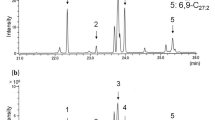Abstract
THE thin waxy materials coating the stem, leaf, flower and fruit of most plants usually consist of homologous series of long chain alcohols, aldehydes, esters and hydrocarbons. The hydrocarbons contain a homologous series of n-alkanes ranging from about C20 to C35 with the alkanes having an odd number of carbon atoms sometimes occurring ten times more abundantly than those with an even number. The centre of the distribution of the series is frequently around the n-alkanes C29 and C31 (ref. 1). These features are also obvious in some hydrocarbons from fossils and it has been suggested that this predominance of n-alkanes with an odd number of carbon atoms can be used to indicate that the hydrocarbons are of biological origin1. For petroleum, which does not have this distribution of n-alkanes, Robinson has proposed that the hydrocarbons arise from partly biological and partly non-biological sources1,2. More recent work has shown that lower organisms such as mosses, algae and lichens contain n-alkanes where the ratio of odd-numbered homologues to the even-numbered ones is about equal, and it was suggested that crude oils may originate from lower organisms3.
This is a preview of subscription content, access via your institution
Access options
Subscribe to this journal
Receive 51 print issues and online access
$199.00 per year
only $3.90 per issue
Buy this article
- Purchase on Springer Link
- Instant access to full article PDF
Prices may be subject to local taxes which are calculated during checkout
Similar content being viewed by others
References
Eglinton, G., and Hamilton, R. J., in Chemical Plant Taxonomy (edit. by Swain, T.), 187 (Academic Press, London and New York, 1963). Douglas, A. G., and Eglinton, G., in Comparative Phytochemistry (edit. by Swain, T.), 57 (Academic Press, London and New York, 1966).
Robinson, R., Catalyst, 6, 42 (1961).
Stransky, K., Streibl, M., and Herout, V., Collection Czech. Chem. Comm., 32, 3213 (1967).
Jackson, B., Locksley, H. D., and Scheinmann, F., J. Chem. Soc., C, 178 (1966); Locksley, H. D., Moore, I., and Scheinmann, F., J. Chem. Soc., C, 430 (1966); Jackson, B., thesis, Univ. Salford (1967).
Kolattukudy, P. E., Phytochemistry, 6, 963 (1967).
Finnegan, R. A., and Eisenbraun, E. J., J. Pharmacol. Sci., 53, 1506 (1964).
Hilditch, T. P., and Williams, P. N., The Chemical Constitution of Natural Fats, fourth ed. (Chapman and Hall, London, 1964).
Cocker, W., McMurry, T. B. H., and Ntamila, M. S., J. Chem. Soc., 1692 (1965).
Borges Del Castillo, J., Brooks, C. J. W., Cambie, R. C., Eglinton, G., Hamilton, R. J., and Pellitt, P., Phytochemistry, 6, 391 (1967).
Author information
Authors and Affiliations
Rights and permissions
About this article
Cite this article
GRICE, R., LOCKSLEY, H. & SCHEINMANN, F. Alkane Distribution as Biological Markers: Presence and Possible Origin of n-Alkanes in Guttiferae Heartwoods. Nature 218, 892–893 (1968). https://doi.org/10.1038/218892a0
Received:
Revised:
Published:
Issue Date:
DOI: https://doi.org/10.1038/218892a0
This article is cited by
-
Plant waxes
Lipids (1970)
Comments
By submitting a comment you agree to abide by our Terms and Community Guidelines. If you find something abusive or that does not comply with our terms or guidelines please flag it as inappropriate.



